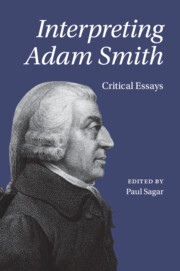Book contents
- Interpreting Adam Smith
- Interpreting Adam Smith
- Copyright page
- Contents
- Contributors
- Acknowledgements
- Abbreviations of Works by Adam Smith
- Introduction
- 1 Smith Scholarship
- 2 The Wealth of Nations as a Work of Social Science
- 3 Adam Smith’s “Industrial Organization” of Religion
- 4 Talking to My Butcher
- 5 What Did Adam Smith Mean? The Semantics of the Opening Key Principles in the Wealth of Nations
- 6 Adam Smith and Virtuous Business
- 7 Adam Smith and the Morality of Political Economy
- 8 A Moral Philosophy for Commercial Society?
- 9 Adam Smith, Sufficientarian
- 10 Narrowing the Scope of Resentment in Smith’s Theory of Moral Sentiments
- 11 Adam Smith
- 12 “Much Better Instructors”
- 13 Sophie de Grouchy as an Activist Interpreter of Adam Smith
- 14 Adam Smith and the Limits of Philosophy
- Bibliography
- Index
5 - What Did Adam Smith Mean? The Semantics of the Opening Key Principles in the Wealth of Nations
Published online by Cambridge University Press: 14 September 2023
- Interpreting Adam Smith
- Interpreting Adam Smith
- Copyright page
- Contents
- Contributors
- Acknowledgements
- Abbreviations of Works by Adam Smith
- Introduction
- 1 Smith Scholarship
- 2 The Wealth of Nations as a Work of Social Science
- 3 Adam Smith’s “Industrial Organization” of Religion
- 4 Talking to My Butcher
- 5 What Did Adam Smith Mean? The Semantics of the Opening Key Principles in the Wealth of Nations
- 6 Adam Smith and Virtuous Business
- 7 Adam Smith and the Morality of Political Economy
- 8 A Moral Philosophy for Commercial Society?
- 9 Adam Smith, Sufficientarian
- 10 Narrowing the Scope of Resentment in Smith’s Theory of Moral Sentiments
- 11 Adam Smith
- 12 “Much Better Instructors”
- 13 Sophie de Grouchy as an Activist Interpreter of Adam Smith
- 14 Adam Smith and the Limits of Philosophy
- Bibliography
- Index
Summary
We present a semantic and textual analysis of the first two chapters of the Wealth of Nations to elucidate the meaning of several of Adam Smith’s key ideas. Using the methodology of the Natural Semantic Metalanguage, we produce semantic explications of some of Adam Smith’s fundamental principles of economics phrased in simple and cross-translatable words. The extracts from the original text function as textual evidence and conceptual reference for the explications we present. We demonstrate that: (i) by reducing the principles as conceived by Smith to their core meanings, it is possible to resolve some interpretive ambiguities for general readers of economics, and (ii) by producing explications that are clear, cross-translatable, and free from terminological ethnocentrism, these principles become accessible and maximally intelligible to twenty-first-century readers who are nonexperts in economics and nonnative speakers of English, too. Ultimately, our project re-humanizes economics as a study of the human condition by drilling down to the core of what Adam Smith the moral philosopher meant in his most famous book that founded a discipline.
- Type
- Chapter
- Information
- Interpreting Adam SmithCritical Essays, pp. 77 - 95Publisher: Cambridge University PressPrint publication year: 2023

